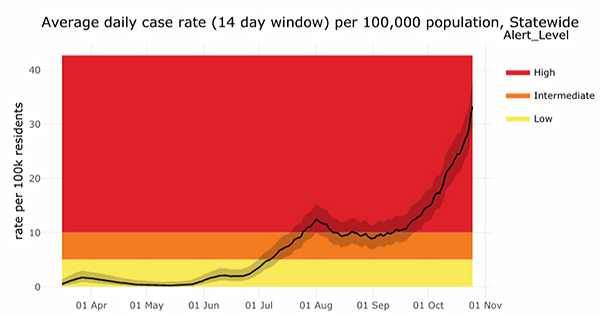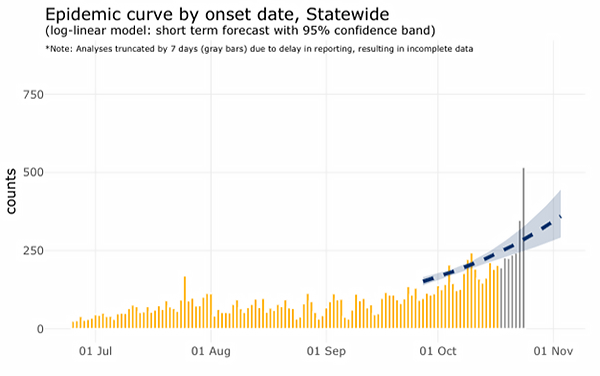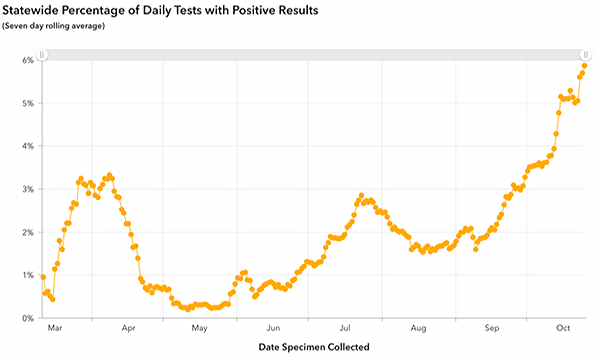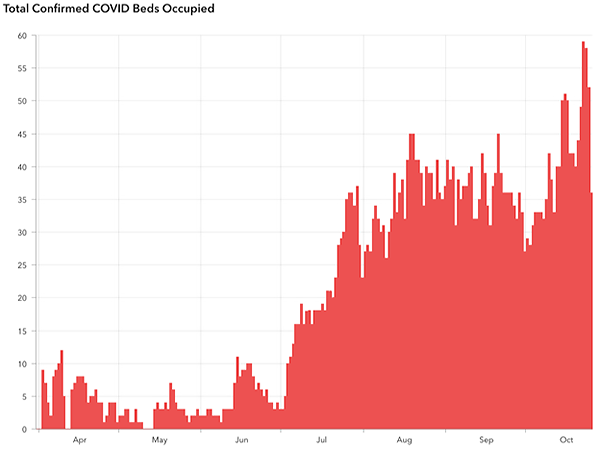Alaska Department of Health and Social Services Weekly Case Analysis
October 18-24, 2020
For ease of reading, the weekly case analysis is now much shorter. Data previously included in this report can be found on the data hub at https://coronavirus-response-alaska-dhss.hub.arcgis.com/.
Brief status report
- Virus transmission across Alaska accelerated for the fourth record week in a row.
- Hospitalizations for COVID-19 have started to rise.
- Testing is not keeping up with new cases.
- Alaskans should get tested immediately at the first sign of any symptoms. Testing is our best tool for understanding virus transmission and risk in our communities.
- Most Alaskans get COVID-19 from a friend, family member or coworker. Alaskans should avoid indoor gatherings with non-household members, wear masks and stay six feet from anyone not in their household.
Case trends and predictions
- For the fourth week in a row, more cases (2,017) were reported in Alaskans this week than any previous week, a 56% increase over last week.
- The statewide positivity rate is at a record high for the fourth week in a row. Increases in testing are not keeping up with increases in cases.
- Cases are increasing in both urban and rural regions. The largest increase in cases was in the Anchorage Municipality, which averaged 146 new cases a day this week, for a 14-day case rate of 40.4. The largest increase in case rate was in the Yukon-Kuskokwim Delta Region, which averaged 39 new cases a day this week, for a 14-day case rate of 100.1.
- An updated model epidemic curve predicts Alaska’s cases will continue to accelerate over the next week and are likely to double again within the next 3-4 weeks or sooner. This model does not take into account the last 7 days’ record case rates, so the true doubling rate is higher.


New cases, hospitalizations and deaths
- The week of October 18-24 saw 2,017 new cases in Alaskans, for a total of 13,012 cumulative cases in Alaskans.
- Cumulative hospitalizations increased to 391 with 30 reported this week.
- Deaths among Alaska residents increased by 1 to 68 total.
- There were 16 nonresident cases identified this week, for a total of 1052.
How COVID-19 spreads in Alaska
- Most new infections among Alaskans are from community spread, not from travel. Most Alaskans get the virus from someone they work, socialize, or go to school with.
- Many cases do not have a clear source, meaning that contact tracers have not been able to identify where the person got the virus. This means that there are cases in our communities that we do not know about.
- Many Alaskans who are diagnosed with COVID-19 report that they went to social gatherings, community events, church services and other social venues while they were contagious but before they knew they had the virus.
- Cases continue to increase fastest among Alaskans aged 20-39, however the proportion of cases in older Alaskans increased slightly again this week. This follows patterns seen in other states of increases in viral transmission occurring in younger age groups first, then followed by increases in older age groups, after which typically an increase in hospitalizations and deaths is seen.
Regional case trends
|
Behavioral Health Region
|
Average new cases Sept 5- Sept 19
|
Average new cases Sept 12- Sept 26
|
Average new cases Sept 20- Oct 3
|
Average new cases Sept 27- Oct 10
|
Average new cases Oct 4- Oct 17
|
Average new cases Oct 18- Oct 24
|
|
Anchorage Municipality
|
13.2
|
16.1
|
21.5
|
28.9
|
32.2
|
40.4
|
|
Fairbanks North Star Borough
|
15.9
|
16.3
|
21.2
|
35.0
|
33.3
|
29.9
|
|
Interior Region except Fairbanks North Star Borough
|
3.1
|
4.9
|
7.9
|
11.3
|
17.1
|
21.6
|
|
Juneau City and Borough
|
16.3
|
12.3
|
7.4
|
7.8
|
14.1
|
23.5
|
|
Kenai Peninsula Borough
|
1.8
|
2.5
|
3.6
|
8.0
|
12.0
|
25.7
|
|
Matanuska-Susitna Region
|
4.7
|
4.0
|
5.9
|
9.7
|
11.5
|
25.8
|
|
Northern Southeast Region
|
3.1
|
4.2
|
4.9
|
2.8
|
2.4
|
7.7
|
|
Northwest Region
|
15.6
|
27.9
|
30.7
|
35.7
|
39.1
|
36.2
|
|
Southern Southeast Region
|
*
|
*
|
*
|
2.2
|
4.3
|
3.2
|
|
Southwest Region
|
3.5
|
3.5
|
4.7
|
6.4
|
7.2
|
9.2
|
|
Yukon-Kuskokwim Delta Region
|
8.4
|
8.7
|
7.1
|
22.3
|
37.2
|
100.1
|
|
Statewide
|
10.2
|
11.7
|
16.3
|
21.4
|
24.3
|
33.3
|
*Insufficient data; low case rate
Positivity rates

- The statewide test positivity rate went from 4.9% to 5.9% this week, which is the fourth week in a row that it is the highest it has ever been.
- Currently, the national average is 6.2%. Since Alaska’s per-capita testing capacity is more robust than 90% of states, a positivity rate near the national average is concerning. Source: Johns Hopkins
- Test positivity can tell us if testing is adequate in an area. The goal is a positivity rate <2%. If the rate is over 5%, it means we are likely missing a lot of cases in that area.
- Test positivity is affected by the number of tests performed as well as the number of new cases in an area.
Health care capacity
- Hospitalizations hit record highs for the second week in a row.
- Currently, 57 Alaskans with confirmed COVID-19 are hospitalized. 13 Alaskans with confirmed COVID-19 are currently requiring intensive care. Two days this week, more than 55 Alaskans were hospitalized with COVID-19 at one time.
- Hospital staffing can change quickly, particularly if a community has many health workers impacted by COVID-19.

COVID-19 and travel
- Travel is not currently thought to be a main factor in most new COVID-19 infections in Alaska, meaning that most Alaskans who get COVID-19 are getting it from social, work or family contacts rather than travel.
- Travel for gatherings remains risky and gets more risky as cases rise across the US. The risk is from being in close contact and enclosed spaces with others while traveling as well as gathering with friends and family members indoors who may have COVID-19 and not know it.
- Alaskans must follow Health Mandate 10.1 when returning from out-of-state travel.
What Alaskans should do
- Anyone with even one new symptom of COVID-19 (fever, chills, cough, shortness of breath, difficulty breathing, fatigue, muscle aches, body aches, headache, new loss of taste or smell, sore throat, congestion, runny nose, nausea, vomiting, or diarrhea), even if it is very mild, should get tested for COVID-19 right away and immediately isolate themselves from others by staying home, staying away from others, and not leaving their house except to seek testing or other medical care. Tests are most accurate in the first few days of symptoms, so testing as soon as possible after the first symptom starts is important, even if the symptom is very mild. Getting tested right away also helps contact tracers move as quickly as possible.
- Alaskans can help contact tracers work to slow the spread of COVID-19 by answering the phone promptly and providing accurate information.
- Alaskans should avoid gatherings, wear masks when around any non-household member, keep six feet of distance from anyone not in their household and wash hands frequently to slow community transmission of COVID-19.
Further information
- The Frequently Asked Questions webpage at https://covid19.alaska.gov/faq/ is often the quickest route to an answer regarding testing, travel, health mandates and other COVID-19 information.
- Please see the State of Alaska COVID-19 information page at http://dhss.alaska.gov/dph/Epi/id/Pages/COVID-19/default.aspx for more information about the virus and how individuals and businesses can protect themselves and others from transmission.
- For the most up-to-date case information, see the Alaska Coronavirus Response Hub dashboard: https://coronavirus-response-alaska-dhss.hub.arcgis.com/. Some data may change as more information comes to light through contact tracing and other public health work.
- For questions regarding DHSS COVID response, including mandates and alerts, email covidquestions@alaska.gov.
- For DHSS media inquiries, please contact clinton.bennett@alaska.gov.
|





